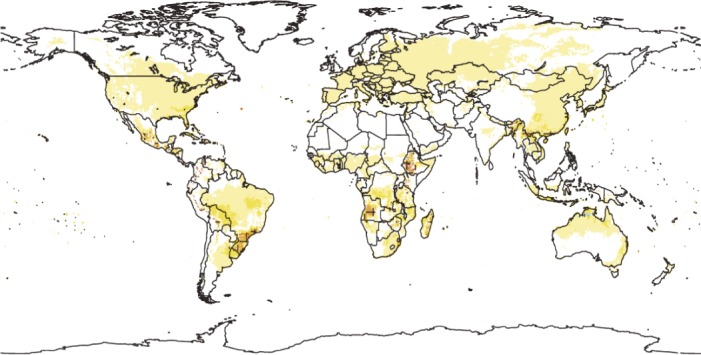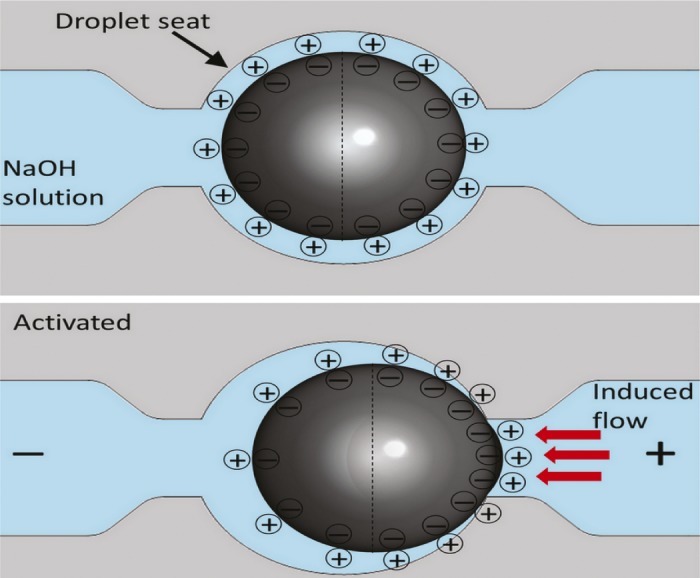Modeling impacts of climate change on malaria risk

Map of possible changes in malaria season length by 2080 under a best-case emissions scenario, with light shading representing a range from a 1-month season shortening through a 1-month season extension, and dark shading representing a season extension of up to 3 months.
The extent of malaria transmission depends on some climatic factors, which influence both the distribution of malaria-carrying mosquitoes and the length of the season in which the mosquitoes are active. Because future climate change may affect malaria transmission, researchers model possible global health impacts. As a part of the Global Climate Impacts: A Cross-Sector, Multi-Model Assessment Special Feature, Cyril Caminade et al. (pp. 3286–3291) compared five malaria impact models based on global climate projections in the 2030s, 2050s, and 2080s, and examined three metrics at global and regional scales: climate suitability for malaria transmission, additional populations at risk for infection, and additional person-months at risk. The models consistently predicted a future malaria risk increase in the tropical highland regions of Africa, South America, and Southeast Asia, the authors report. However, the models did not agree regarding malaria risk and changes in epidemic transmission in a number of other regions. While the modeled increase in risk to tropical highlands regions appears robust, the results suggest that further research is needed to improve malaria impact models and reduce uncertainties. The next generation of malaria models will need to include land use, population change, and socioeconomic factors for a robust impact assessment of future malaria risk, according to the authors. — P.G.
Liquid metal at the heart of a microscale pump

Schematic of liquid metal droplet charge distribution.
Pumping liquid at microscale with conventional pump designs requires intricate fabrication processes and a high input of energy relative to the amount of liquid pumped. Because micro-scale pumps may be central to many lab-on-a-chip and micro-electromechanical systems, the limitations of such pumps present a significant design hurdle. To demonstrate an elegant pump design, Shi-Yang Tang et al. (pp. 3304–3309) placed a droplet of the liquid metal Galinstan and a basic solution in a looped plastic channel, flanked by two electrodes. The Galinstan metal, comprising gallium, indium, and tin, creates a negative surface charge when suspended in the solution. When the electrodes are turned on, the authors report, the external electrical potential changes the charge distribution on the liquid metal sphere, propelling liquid around the sphere and through the loop in a process called continuous electrowetting. The liquid metal enabled sustained flow rates up to 5000 μL per minute using less than 15 mW of power. Further, reversing the electrical field reversed the flow direction, and altering the frequency, magnitude, and waveform of the applied electrical signal, as well as the size of the Galinstan droplet, adjusted the flow rate. The results suggest that microscale pumping can be accomplished with high energy efficiency and without moving mechanical parts, according to the authors. — P.G.
Habitat fragmentation and seed dispersal

Seeds of Vernonia angustifolia that disperse by wind.
Habitat fragmentation can restrict the movement and dispersal of organisms that travel over land or are moved by other organisms, but species dispersed by wind are often assumed to move freely. Ellen Damschen et al. (pp. 3484–3489) examined seed dispersal in experimental landscapes to determine whether habitat fragmentation affects air flow and whether connective corridors between isolated habitat patches might alleviate reductions in dispersal of wind-dispersed plant species. The authors combined airflow predictions from a fluid-dynamics model with experimental wind and seed dispersal data from 1.37 hectare connected and unconnected habitat patches to evaluate the impacts of fragmentation on seed dispersal. The model predicted higher wind speed, uplift, and redirection of airflow in connected habitat patches than in isolated patches; the predicted factors promote long-distance seed dispersal. Experimental seed releases confirmed that seeds traveled farther in connected habitat patches than in isolated patches, and 12 years of plant community data documented 15% more species in connected patches versus isolated patches, especially those aligned with the predominant wind direction. The results suggest that wind-dispersed plant species may benefit from corridors between open habitat patches by increasing long-distance seed dispersal and facilitating species colonization and persistence, according to the authors. — J.J.
Spatial variation in vaccine efficacy

Efficacy of PCV against all clinical pneumonia.
Vaccination against pneumococcal disease can prevent many childhood deaths due to pneumonia, yet the cost of the vaccines is a deterrent to their incorporation into many developing countries’ immunization strategies. To determine the populations who might benefit most from a targeted immunization approach, Elisabeth Root et al. (pp. 3520–3525) examined the results of a study in which more than 12,000 children under age 2 were immunized with a pneumococcal conjugate vaccine in Bohol, Philippines. Geographic data allowed the authors to locate each child’s residence relative to Bohol Regional Hospital, the main study hospital. The authors examined records of childhood pneumonia cases, comparing incidence rates between vaccinated and unvaccinated children by pneumonia severity to develop measures of vaccine efficacy throughout the study area. The authors found that vaccine efficacy improved with distance from Bohol Regional Hospital, and suggest that travel difficulties may prevent rural parents from seeking treatment for their children until later stages of pneumonia, resulting in a disparity between the severity of vaccinated and unvaccinated children’s pneumonia and the observed spatial variation in vaccine efficacy. The results suggest a method for estimating the benefits of a targeted vaccination strategy, and that such a strategy may reduce the overall costs of vaccination in developing countries, according to the authors. — P.G.
Potential biomarker for major depressive disorder

Potential biomarker for clinical depression in male adolescents. Image courtesy of Wikimedia Commons/Sander van der Wel.
The occurrence of major depressive disorder during childhood or adolescence is thought to increase the risk of the condition during adulthood, yet there are few reliable clinical biomarkers to identify individuals at varying risk of the disorder. Following a recent National Institute of Mental Health recommendation to develop so-called “Research Domain Criteria” for classifying individuals with mental disorders, Ian Goodyer et al. (pp. 3638–3643) recruited 1,858 adolescents, ages 12–19 years, from communities in the United Kingdom, and classified the participants into four distinct groups based on longitudinal, self-reported questionnaires of depressive symptoms and morning levels of salivary cortisol, a stress hormone associated with depression. The authors report that when compared with a group of adolescents with low levels of cortisol and depressive symptoms, the other three groups displayed progressively higher odds ratios of major depression: Group 4, which accounted for 17% of the study participants and contained those with elevated cortisol and depressive symptoms, had an odds ratio of 7.1 for major depression, compared with group 1, which displayed low morning cortisol and depressive symptoms. In group 4, boys, in particular, had a cortisol-related elevated risk of major depression, the authors report. In contrast, both boys and girls in group 4 showed an increased propensity for “overgeneral memory,” a depression-related characteristic that impairs individuals’ ability to retrieve specific details in recollections of autobiographical events. According to the authors, the findings underscore the significance of gender-related similarities and differences in susceptibility to clinical depression. — P.N.


